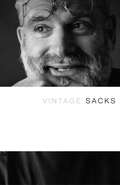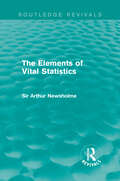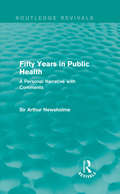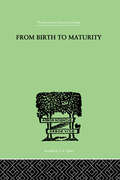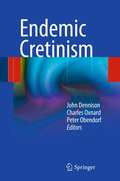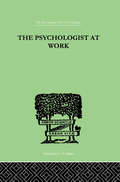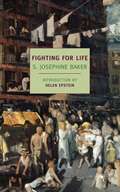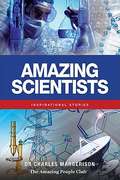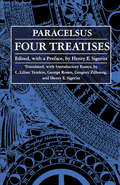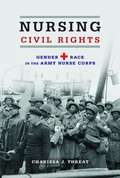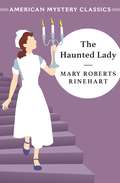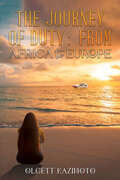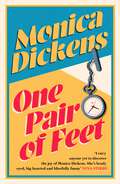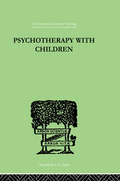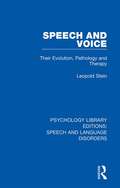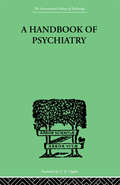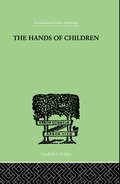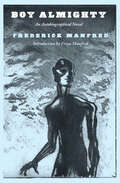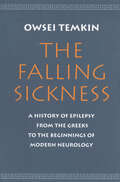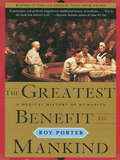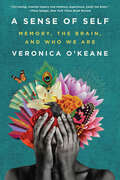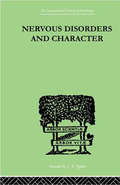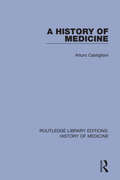- Table View
- List View
Vintage Sacks
by Oliver SacksVintage Readers are a perfect introduction to some of the great modern writers presented in attractive, accessible paperback editions."It is Dr. Sacks's gift that he has found a way to enlarge our experience and understanding of what the human is." --The Wall Street JournalDubbed "the poet laureate of medicine" by The New York Times, Oliver Sacks is a practicing neurologist and a mesmerizing storyteller. His empathetic accounts of his patients's lives--and wrily observed narratives of his own--convey both the extreme borderlands of human experience and the miracles of ordinary seeing, speaking, hearing, thinking, and feeling. Vintage Sacks includes the introduction and case study "Rose R." from Awakenings (the book that inspired the Oscar-nominated movie), as well as "A Deaf World" from Seeing Voices; "The Visions of Hildegard" from Migraine; excerpts from "Island Hopping" and "Pingelap" from The Island of the Colorblind; "A Surgeon's Life" from An Anthropologist on Mars; and two chapters from Sacks's acclaimed memoir Uncle Tungsten.From the Trade Paperback edition.
The Elements of Vital Statistics (Routledge Revivals)
by Sir Arthur NewsholmeFirst published in 1889, this book provides a guide to vital statistics- the science of numbers applied to the life-history of communities and nations- in relation to medical problems. Chapters cover a wide variety of categories including population, births and deaths, sickness, occupation and mortality, and mortality from special diseases.
Fifty Years in Public Health: A Personal Narrative with Comments (Routledge Revivals)
by Sir Arthur NewsholmeFirst published in 1935, this book provides a valuable contribution to the history of Public Health and Preventive Medicine. Written as a recollection of the experiences and knowledge of Sir Arthur Newsholme, the book covers a period in which phenomenal progress was made.
From Birth to Maturity: An Outline of the Psychological Development of the Child (International Library Of Psychology Ser. #Vol. 67)
by Bhler, CharlotteFirst published in 1999. Routledge is an imprint of Taylor & Francis, an informa company.
Endemic Cretinism
by Peter Obendorf John Dennison Charles OxnardResponding to a renewed interest in the growing problem of iodine deficiency worldwide, Drs. Charles Oxnard and Peter Obendorf, along with experienced translator and anatomist John Dennison, take a fresh look at the classic text, Der endemische Kretinismus, published in 1936 by Springer. Translated here for the first time into English, this landmark text will be a welcome resource for researchers confronting the problem of iodine deficiency. Oxnard and Obendorf point out that there is very little detailed knowledge or numerical data on cretinism available in the English-speaking world. In addition, highly-renowned Professor Basil S. Hetzel, recently-retired World Health Organization Chairman of the International Council for Control of Iodine Deficiency Disorders, published in 2009 with Dr Chen Zu-pei on the resurgence of iodine deficiency in China. Indeed, throughout the entire developing world there may be as many as two billion people at risk to iodine deficiency; perhaps three quarters of a billion have goiter, and ten million may be cretins. Even in developed countries, iodine deficiency is re-emerging (as in New South Wales in 19% of children) with the result of significantly reduced numbers of gifted children (though this is not cretinism per se). Certain to be of significant interest to a wide range of researchers, health providers and professionals, including government health administrators, this English translation of Endemic Cretinism is a major contribution to the literature.
The Psychologist At Work: An Introduction to Experimental Psychology (International Library Of Psychology Ser. #Vol. 106)
by Harrower, M RFirst Published in 1999. Routledge is an imprint of Taylor & Francis, an informa company.
Fighting for Life
by S. Josephine Baker Helen EpsteinNew York's Lower East Side was said to be the most densely populated square mile on earth in the 1890s. Health inspectors called the neighborhood "the suicide ward." Diarrhea epidemics raged each summer, killing thousands of children. Sweatshop babies with smallpox and typhus dozed in garment heaps destined for fashionable shops. Desperate mothers paced the streets to soothe their feverish children and white mourning cloths hung from every building. A third of the children living there died before their fifth birthday.By 1911, the child death rate had fallen sharply and The New York Times hailed the city as the healthiest on earth. In this witty and highly personal autobiography, public health crusader Dr. S. Josephine Baker explains how this transformation was achieved. By the time she retired in 1923, Baker was famous worldwide for saving the lives of 90,000 children. The programs she developed, many still in use today, have saved the lives of millions more. She fought for women's suffrage, toured Russia in the 1930s, and captured "Typhoid" Mary Mallon, twice. She was also an astute observer of her times, and Fighting for Life is one of the most honest, compassionate memoirs of American medicine ever written.
Amazing Scientists
by Charles MargerisonWhat would Charles Darwin say if he was interviewed about his life and work? How would Galileo reflect upon his contribution to scientific discovery? In their day, there were few newspapers or journalists to tell these stories, however in Amazing Scientists, the stories of amazing people including Isaac Newton, Linus Pauling, and Louis Pasteur come alive. The bounds of possibility in the many fields of science, including chemistry, physics, psychology, engineering and medicine, are always being stretched. This book helps us understand the ways in which this can happen, through the life stories of people who have made such achievements.This unique collection of short life stories reveals the lives some of the world's greatest and most influential scientists. Meet Einstein, Curie, Faraday, Newton, Tesla and Salk, and get a very personal sense of what they achieved in their lives. Understand the challenges and risks they all faced. Explore the social as well as the technical aspects of their lives. Be inspired as their stories come alive through BioViews® which offer new perspective on the lives of these amazing people.What is a BioView®? A BioView® is a short biographical story, similar to an interview, about an amazing person. The stories can be read in around ten minutes. They provide an easy way of learning about people who made major contributions to our world. The unique format and flow enables each person's story to come alive, as if it is being personally told to you and reflects their interests, emotions and passions. These are unique life stories that can provide you with inspiration in your own life.Visit www.amazingpeopleclub.com to explore this exciting range of books and audio resources.
Four Treatises of Theophrastus Von Hohenheim Called Paracelsus
by ParacelsusFour treatises which illustrate one of the most original minds of the Renaissance at the height of his powers.Born near Einsiedeln in 1493, Philip Theophrastus von Hohenheim, who later called himself Paracelsus, was the son of a physician. His thirst for knowledge led him to study arts in Vienna, then medicine in Italy, but the instruction left him disillusioned. He had learned to see nature with his own eyes, undiluted by the teachings of books. He was a rebellious spirit, hard-headed and stubborn, who travelled all over Europe and the British Isles to practice medicine, study local diseases, and learn from any source he could, humble as it might be. In these years of wanderings, Paracelsus developed his own system of medicine and a philosophy of theology all his own. Though he wrote a great many books that covered a wide range of subjects, only a few of his works were ever published in his lifetime. When he died in Salzburg in 1541, one of the most forceful personalities of the Renaissance died with him. Here are collected four treatises which illustrate four different aspects of Paracelsus' work. The first gives a passionate justification of his character, activities, and views, and gives a picture of the man and his basic ideas. The second treatise is a study of the diseases of miners, with whom Paracelsus had spent a great deal of time. Then follows a treatise on the psychology and psychiatry of Paracelsus. Written at a time when mental diseases were beginning to be studied and treated by physicians, this pioneering essay anticipates a number of modern views. The last essay, entitled "A Book on Nymphs, Sylphs, Pygmies, and Salamanders, and on the Other Spirits," is a fanciful and poetic treatment of paganism and Greek mythology, as well as a good sample of Paracelsus' philosophy and theology. Together these essays show one of the most original minds of the Renaissance at the height of his powers.
Nursing Civil Rights: Gender and Race in the Army Nurse Corps (Women, Gender, and Sexuality in American History)
by Charissa J. ThreatIn Nursing Civil Rights, Charissa J. Threat investigates the parallel battles against occupational segregation by African American women and white men in the U.S. Army. As Threat reveals, both groups viewed their circumstances with the Army Nurse Corps as a civil rights matter. Each conducted separate integration campaigns to end the discrimination they suffered. Yet their stories defy the narrative that civil rights struggles inevitably arced toward social justice. Threat tells how progressive elements in the campaigns did indeed break down barriers in both military and civilian nursing. At the same time, she follows conservative threads to portray how some of the women who succeeded as agents of change became defenders of exclusionary practices when men sought military nursing careers. The ironic result was a struggle that simultaneously confronted and reaffirmed the social hierarchies that nurtured discrimination.
The Haunted Lady (The\hilda Adams Mysteries Ser. #2)
by Mary Roberts RinehartA very very rich dowager is being scared to death . . .A classic whodunit by a #1 bestselling author who 'helped the mystery series grow up" (New York Times)First a cloud of bats; then rats - it looks like someone is trying to frighten Eliza Fairbanks into her grave. At least that's what the elderly widow claims is being done to her. Nurse Hilda Adams, aka "Miss Pinkerton" to the Homicide Bureau, believes Eliza's fears could just be true . . .And when a dubious assortment of relatives come visiting Eliza at the mansion, it's Hilda's job to keep an eye on Eliza before a potential killer resorts to more definitive means. And considering all the bad blood running through the heart of the Fairbanks family, it might already be too late to save her charge.
The Journey of Duty: From Africa to Europe
by Olgett KazimotoEarly life experiences of the author in the northern province of Zambia in Africa, and training in healthcare with subsequent employment in the mining industry healthcare owned jointly by the Anglo-American Corporation and the Government of the Republic of Zambia, mark the beginning of the journey of duty. After working for eight years from 1990 to 1998, this initial part of the journey of duty becomes full of challenging encounters and adventure stories associated with copper mining operations. Moving to Britain as a migrant worker marks the second part of the long journey of duty. Over the next 22 years, the author is immersed in the busy National Health Service (NHS), an umbrella organisation for thousands of hospitals and allied institutions. Experiencing the British way of life becomes fascinating but then part of this way of life is about how politics influence the way healthcare is delivered by the NHS which takes the centre stage throughout the rest of this book. The NHS tales about itsorigins, evolution, inspiring radical transformation in the 21st century, traffic light targets, and the dark times of scandals with red tape are quite revealing especially for people intending to work, train or are working as healthcare professionals. In the thick of it are some of the shining stars with rare qualities of fixing the broken parts of the healthcare systems that end this book.
One Pair of Feet: The Entertaining Memoirs of a Young Nurse During World War II: A Virago Modern Classic (Vmc Ser. #108)
by Monica DickensOne Pair of Feet is not just a spirited and entertaining account of the training of a hospital nurse in wartime but a fascinating glimpse into a time and a culture so recent and yet so utterly changed' Marina LewyckaAs the effects of the war raging in Europe begin to be felt at home in London, Monica Dickens decides to do her bit and to pursue a new career, and so enrols as a student nurse at a hospital in rural Hertfordshire. By nature clever and spirited, she struggles to submit to the iron rule of the Matron and Sisters, and is alternately infuriated and charmed by her patients. That's not to mention the mountains of menial work that are a trainee's lot. But there are friends among the staff and patients, night-time escapades to dances with dashing army men, and her secret writing project to keep her going.'A brilliantly funny account' Elizabeth Bowen
One Pair of Feet: The Entertaining Memoirs of a Young Nurse During World War II: A Virago Modern Classic (Virago Modern Classics #104)
by Monica DickensOne Pair of Feet is not just a spirited and entertaining account of the training of a hospital nurse in wartime but a fascinating glimpse into a time and a culture so recent and yet so utterly changed' Marina LewyckaAs the effects of the war raging in Europe begin to be felt at home in London, Monica Dickens decides to do her bit and to pursue a new career, and so enrols as a student nurse at a hospital in rural Hertfordshire. By nature clever and spirited, she struggles to submit to the iron rule of the Matron and Sisters, and is alternately infuriated and charmed by her patients. That's not to mention the mountains of menial work that are a trainee's lot. But there are friends among the staff and patients, night-time escapades to dances with dashing army men, and her secret writing project to keep her going.'A brilliantly funny account' Elizabeth Bowen
Psychotherapy with Children
by Frederick H. AllenFirst published in 1999. Routledge is an imprint of Taylor & Francis, an informa company.
Speech and Voice: Their Evolution, Pathology and Therapy (Psychology Library Editions: Speech and Language Disorders)
by Leopold SteinOriginally published in 1942, this title was recognised as setting new standards in the scientific approach to speech problems. Much speech therapy in the past had been unsatisfactory because of its emphasis upon the purely mechanical aspects of the condition, while at the same time the purely psychological approach was not sufficient to lead to satisfactory and radical treatment either. In this title the author combines the two approaches and by setting out the basic pathology of the various conditions, he throws new light upon them. Today it can be read and enjoyed in its historical context.
I Served on Bataan
by Juanita RedmondThe true story of an Army nurse trapped in the Philippines during the beginning of America's entrance in WWII.
A Handbook Of Psychiatry (International Library Of Psychology)
by P.M. Lichtenstein S.M SmallThis is Volume XI of nineteen in collection of Abnormal and Clinical Psychology. Originally published in 1944, this book looks at the area of normality and abnormality. Normalcy is a relative term and its patterns vary continuously.
The Hands Of Children: AN INTRODUCTION TO PSYCHO-CHIROLOGY (International Library Of Psychology Ser.)
by Julius SpierThis is Volume XVIII in a series of twenty-one in a collection on Individual Differences. Originally published in 1931, this posthumously published work provides the reader with an introduction to psych-chirology with additions by the current editor's experiments and anaylsis. With an Appendix on the Hands of the Mentally Diseased by Herta Levi.
Boy Almighty: An Autobiographical Novel
by Frederick ManfredFrederick Manfred was the author of Lord Grizzly, finalist for the National Book Award, as well as twenty-six other novels and short story collections, many of which explore nuanced struggles with death and other life challenges which demand toughness and resilience. Although a work of fiction, Boy Almighty conveys Manfred&’s dramatic personal story of contracting tuberculosis as a young man and being cared for at a convalescent home at the Glen Lake Sanatorium in Minnesota. A remarkable blend of stream-of-consciousness and objective reporting, Boy Almighty is the story of a man in the throes of dissolution and disintegration from tuberculosis and of his recovery, reintegration, and rebirth. Eric Frey, sensitive, aware, in love with life, yet beset with frustration and failure, is at first too ill to be placed in a tubercular ward, where his almost certain death would be upsetting to the other patients. Running concurrently with the inner story of Frey&’s mind is the story of his body&’s struggle to survive. Boy Almighty is a profound and compelling study of a man who desperately wants to live and of his relationships with doctors, nurses, roommates, and a fellow patient who teaches him the meaning of love.
The Falling Sickness: A History of Epilepsy from the Greeks to the Beginnings of Modern Neurology
by Owsei Temkin"A thoroughly admirable and informative introduction to our knowledge of epilepsy in the Western world from antiquity to the early twentieth century." - American ScientistOwsei Temkin presents the history of epilepsy in Western civilization from ancient times to the beginnings of modern neurology. First published in 1945 and thoroughly revised in 1971, this classic work by one of the history of medicine's most eminent scholars now returns to print available in both paperback and eBook formats.
The Greatest Benefit to Mankind: A Medical History of Humanity (The Norton History of Science)
by Roy Porter"To combine enormous knowledge with a delightful style and a highly idiosyncratic point of view is Roy Porter's special gift, and it makes [this] book . . . alive and fascinating and provocative on every page."--Oliver Sacks, M.D. Hailed as "a remarkable achievement" (Boston Sunday Globe) and as "a triumph: simultaneously entertaining and instructive, witty and thought-provoking . . . a splendid and thoroughly engrossing book" (Los Angeles Times), Roy Porter's charting of the history of medicine affords us an opportunity as never before to assess its culture and science and its costs and benefits to mankind. Porter explores medicine's evolution against the backdrop of the wider religious, scientific, philosophical, and political beliefs of the culture in which it develops, covering ground from the diseases of the hunter-gatherers to today's threat of AIDS and ebola, from the clearly defined conviction of the Hippocratic oath to the muddy ethical dilemmas of modern-day medicine. Offering up a treasure trove of historical surprises along the way, this book "has instantly become the standard single-volume work in its field" (The Lancet). "The author's perceptiveness is, as usual, scalpel-sharp; his manner genially bedside; his erudition invigorating." - Simon Schama
A Sense of Self: Memory, The Brain, And Who We Are
by Veronica O'KeaneHow do our brains store—and then conjure up—past experiences to make us who we are? A twinge of sadness, a rush of love, a knot of loss, a whiff of regret. Memories have the power to move us, often when we least expect it, a sign of the complex neural process that continues in the background of our everyday lives. This process shapes us: filtering the world around us, informing our behavior and feeding our imagination. Psychiatrist Veronica O’Keane has spent many years observing how memory and experience are interwoven. In this rich, fascinating exploration, she asks, among other things: Why can memories feel so real? How are our sensations and perceptions connected with them? Why is place so important in memory? Are there such things as “true” and “false” memories? And, above all, what happens when the process of memory is disrupted by mental illness? O’Keane uses the broken memories of psychosis to illuminate the integrated human brain, offering a new way of thinking about our own personal experiences. Drawing on poignant accounts that include her own experiences, as well as what we can learn from insights in literature and fairytales and the latest neuroscientific research, O’Keane reframes our understanding of the extraordinary puzzle that is the human brain and how it changes during its growth from birth to adolescence and old age. By elucidating this process, she exposes the way that the formation of memory in the brain is vital to the creation of our sense of self.
Nervous Disorders And Character: A Study in Pastoral Psychology and Psychotherapy (International Library Of Psychology Ser.)
by McKENZIE, John GFirst published in 1999. Routledge is an imprint of Taylor & Francis, an informa company.
A History of Medicine (Routledge Library Editions: History of Medicine #2)
by Arturo CastiglioniOriginally published in 1941, A History of Medicine provides a detailed and comprehensive guide to the advancement of medicine, from Ancient Egypt, and Ancient Babylonia, all the way up to the 20th century. The book looks at the close relationship between the progress of medicine and its advancement of civilization, it covers the development of medicine from, old magical rites, religious creeds, classical Hippocratism and revolutionary discoveries, while looking at the associated economic, intellectual, and political conditions of life in different nations, during different times. The book provides an essential and detailed look at the rich history of medicine and how it has impacted society.
